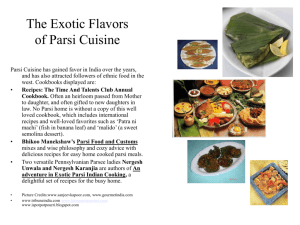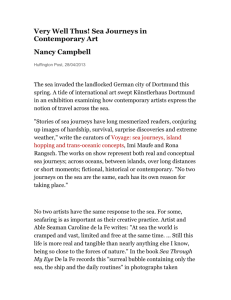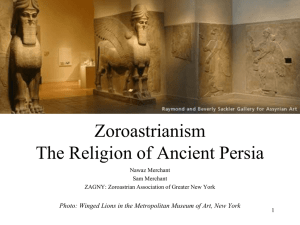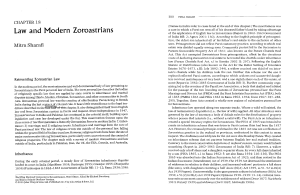A Larger World - WordPress.com
advertisement
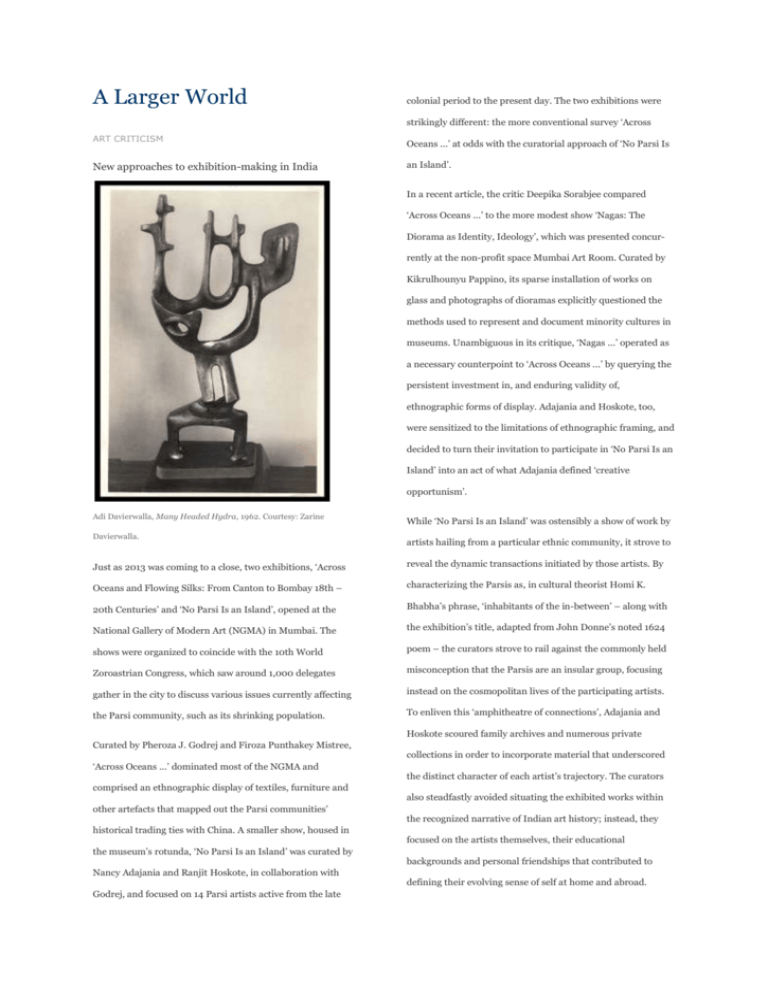
A Larger World colonial period to the present day. The two exhibitions were strikingly different: the more conventional survey ‘Across ART CRITICISM New approaches to exhibition-making in India Oceans ...’ at odds with the curatorial approach of ‘No Parsi Is an Island’. In a recent article, the critic Deepika Sorabjee compared ‘Across Oceans ...’ to the more modest show ‘Nagas: The Diorama as Identity, Ideology’, which was presented concurrently at the non-profit space Mumbai Art Room. Curated by Kikrulhounyu Pappino, its sparse installation of works on glass and photographs of dioramas explicitly questioned the methods used to represent and document minority cultures in museums. Unambiguous in its critique, ‘Nagas ...’ operated as a necessary counterpoint to ‘Across Oceans ...’ by querying the persistent investment in, and enduring validity of, ethnographic forms of display. Adajania and Hoskote, too, were sensitized to the limitations of ethnographic framing, and decided to turn their invitation to participate in ‘No Parsi Is an Island’ into an act of what Adajania defined ‘creative opportunism’. Adi Davierwalla, Many Headed Hydra, 1962. Courtesy: Zarine Davierwalla. While ‘No Parsi Is an Island’ was ostensibly a show of work by artists hailing from a particular ethnic community, it strove to Just as 2013 was coming to a close, two exhibitions, ‘Across reveal the dynamic transactions initiated by those artists. By Oceans and Flowing Silks: From Canton to Bombay 18th – characterizing the Parsis as, in cultural theorist Homi K. 20th Centuries’ and ‘No Parsi Is an Island’, opened at the Bhabha’s phrase, ‘inhabitants of the in-between’ – along with National Gallery of Modern Art (NGMA) in Mumbai. The the exhibition’s title, adapted from John Donne’s noted 1624 shows were organized to coincide with the 10th World poem – the curators strove to rail against the commonly held Zoroastrian Congress, which saw around 1,000 delegates misconception that the Parsis are an insular group, focusing gather in the city to discuss various issues currently affecting instead on the cosmopolitan lives of the participating artists. the Parsi community, such as its shrinking population. To enliven this ‘amphitheatre of connections’, Adajania and Hoskote scoured family archives and numerous private Curated by Pheroza J. Godrej and Firoza Punthakey Mistree, ‘Across Oceans ...’ dominated most of the NGMA and comprised an ethnographic display of textiles, furniture and other artefacts that mapped out the Parsi communities’ historical trading ties with China. A smaller show, housed in the museum’s rotunda, ‘No Parsi Is an Island’ was curated by Nancy Adajania and Ranjit Hoskote, in collaboration with Godrej, and focused on 14 Parsi artists active from the late collections in order to incorporate material that underscored the distinct character of each artist’s trajectory. The curators also steadfastly avoided situating the exhibited works within the recognized narrative of Indian art history; instead, they focused on the artists themselves, their educational backgrounds and personal friendships that contributed to defining their evolving sense of self at home and abroad. The greatest revelations in ‘No Parsi Is an Island’ were the scrap metal and steel sculptures of Piloo Pochkhanawala and Adi Davierwalla, both autodidacts who drew on the legacy of 20th century Western sculpture when forging their own distinctive modernist idioms. As well as the finished sculptures, the show included sketchbooks and journals – and, in the case of Davierwalla, a selection of photographs from his archive, in which he meticulously maintained a record of every work he made. Other highlights were the weavings of Nelly Sethna, who shared a fruitful association with Finnish architect Eero Saarinen, and non-figurative painter Homi Patel. The decision to include the personal photographic archive of Davierwalla alongside the children’s magazines that abstract painter Mehlli Gobhai illustrated in the late 1960s and early ’70s, Shiavax Chavda’s research for the costumes for the film Amrapali(1966) and the poetry of painter Gieve Patel – to list but a few examples – was an attempt by the curators to demonstrate these artists’ ‘expanded practices’. As Adajania explained to me, they were able to ‘range across cultural fields and political urgencies at large. Their ability to engage with diverse economies of cultural production as producers, as interlocutors, and as collaborators […] this is a major lesson that Indian artists today could imbibe: that art is not confined to a few institutions within the art market. To be truly effective, the life of the imagination must surge across a variety of spheres of human activity and expression.’ The ‘creative opportunism’ of ‘No Parsi Is an Island’ is significant. Compellingly, it offered stratagems and ways to negotiate with overarching and limiting institutional frameworks by examining the strength of culturally received histories, and thinking beyond location, community and ethnicity, while celebrating the overlooked, forgotten and marginalized. Shanay Jhaveri Shanay Jhaveri is a contributing editor of frieze and lives in Mumbai, India, and London, uk. Issue 162 , April 2014


